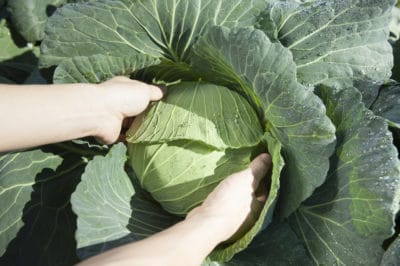Days to Maturity
Early, mid-season, and late cabbages are classified by how many days it takes them to mature.
Early cabbages, like Primo or Golden Acre, mature in 35 to 70 days. In general, early cabbages form smaller heads. Smaller heads of cabbage don’t store as well as larger heads. It’s expected, though, that these first cabbages from the garden won’t be stored, but that they will be eaten quickly.
Mid-season cabbages, like Green Cup or Ruby Ball, mature in 70 to 80 days. Since they mature at a time when the garden is producing vegetables on a regular basis, it’s expected that the heads might be stored for some short periods of time, so, these cabbages produce larger heads.
Late season cabbages, like Lei Choy or Ruby Perfection, take the longest to mature, over 85 days. It’s expected that these cabbages might be stored in a root cellar for a few months or preserved as sauerkraut or kimchi for use over the winter, so these cabbages form the largest heads.
Maturity dates for some cabbages include:
- Early Jersey Wakefield – 63 days
- Ruby Ball – 70 days
- Green Cup 73 days
- Savoy Ace – 74 days
- King Cole – 78 days
- Ruby Perfection – 80 days
- Savoy King – 85 days
As mentioned, though, these dates are based on ideal growing conditions. You can use them as a guide that tells you when to start checking your cabbage to see if it’s ready to pick.
The Real Guide to Maturity
The real guide to maturity is how the head feels when you squeeze it in your hand. A head of cabbage may be beautifully shaped and look well filled out, but the underlying leaves may still be loose and not fully compacted.
The only way to be certain that your cabbage is ready to harvest is to squeeze it. When squeezed, the head should feel solid and firm. It should not give any where under your grip. If the cabbage head does not yet feel firm, check it again in a day or two, but if it feels solid, it’s ready to harvest.
You should harvest small heads of cabbage as soon as they feel solid. You can, however, leave larger heads in your garden for a few days unless rain is in the weather forecast. Rain, especially a heavy rain, can cause a growth spurt that causes cabbage heads to split.
So, even if you aren’t quite ready, you will have to harvest any ripe cabbages you have before it rains.
Wrap the smaller heads loosely in plastic wrap or place them in a loose fitting plastic bag to allow air to circulate around them, and you will be able to keep them in your refrigerator for about two weeks. If you have a root cellar or a place where you can duplicate root cellar conditions, store the larger heads there.
Reaping the Rewards of Maturity
When you are ready to reap the rewards of having raised your cabbages to maturity, cut off their heads. Use a sharp knife and cut the head from the stem close to the base of the head.
You may be able to get a second harvest of smaller, looser cabbage heads if you leave the roots and outer leaves in your garden, especially in the case of early cabbages.
If new heads appear, pinch off all but three or four. Even though the heads will feel loose, harvest them when they are about the size of tennis balls and use them in salads or stir fries.
